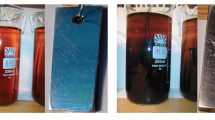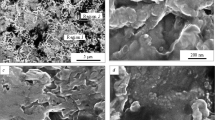Abstract
The critical current densities for passivation of a number of industrial stainless steels and nickel-based alloys have been measured in 20% H2SO4 at temperatures from 30 to 103° C (boiling). The critical current decreases — and then the aptitude for passivation increases — as the chromium and molybdenum contents of the alloys are increased; molybdenum was about three times as effective as chromium. Increasing the temperature extends the range of active dissolution of the alloys and markedly increases the critical current density for passivation. The effect is least severe for the alloys of high Cr and Mo content, but even for these, spontaneous passivation does not take place above 50° C. The logarithm of the active current density varies linearly with the reciprocal of absolute temperature over limited ranges. Apparent activation energies have been measured and proposals for the rate-determining factors in the mechanisms are outlined on the basis of these measurements.
Similar content being viewed by others
References
J. L. Crolet,Aciers Spéciaux 42 (1978) 21.
R. L. Cowan and C. S. Tedmon, ‘Advances in Corrosion Science and Technology’, Vol. 3, Plenum Press, New York (1973) p. 308.
M. S. El Basiouny and S. Haruyama,Corrosion Sci. 16 (1976) 529.
R. Machin and P. Guha,Werkstoffe und Korrosion 25 (1974) 40.
R. B. Leonard,Corrosion 24 (1969) 301.
J. M. Defranoux,Aciers Spéciaux 31 (1975) 8.
J. C. Charbonnier,Métaux-Corrosion-Industrie 598 (1975) 1–24.
G. Hersleb and W. Schwenk,Werkstoffe und Korrosion 18 (1967) 521.
M. B. Rockel,Corrosion 29 (1973) 393.
K. Vu Quang, F. Bourelier, E. Chassaing and J. Montuelle,Mém. Sci. Rev. Mét. 70 (1973) 417.
B. L. Trout and R. D. Daniels,Corrosion 28 (1972) 331.
M. Turner, G. E. Thompson and P. A. Brook,Corrosion Sci. 13 (1973) 985.
G. Gilli, P. Borea, F. Zucchi and G. Trabanelli,Corrosion Sci. 9 (1969) 673.
J. L. Crolet, J. Seraphin and R. Tricot,Mém. Sci. Rev. Mét. 74 (1977) 281.
M. Kesten and H. G. Feller,Electrochimica Acta 16 (1971) 763.
Author information
Authors and Affiliations
Rights and permissions
About this article
Cite this article
Quang, K.V., Traisnel, M., Damie, P. et al. Influence of chemical composition and temperature on the passivation of some stainless steels and nickel-based alloys in sulphuric acid. J Appl Electrochem 10, 703–708 (1980). https://doi.org/10.1007/BF00611273
Received:
Issue Date:
DOI: https://doi.org/10.1007/BF00611273




